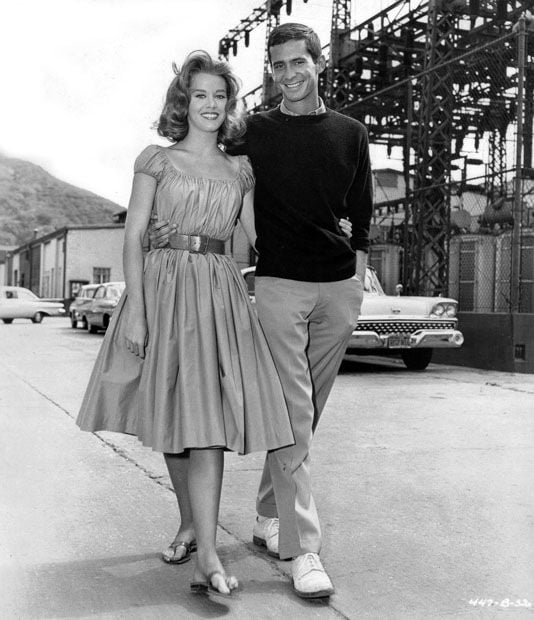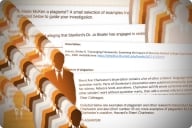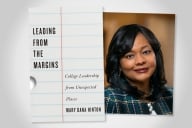You have /5 articles left.
Sign up for a free account or log in.
 The cover of Going to College in the Sixties (Johns Hopkins University Press) features a photograph of a protest at the University of California, Berkeley. Among the photographs in the book that might have been more emblematic of the book’s contents was the one at right promoting a film, Tall Story, that starred a (pre-radical days) Jane Fonda and Anthony Perkins and was a farce about campus romance, reflecting what Hollywood believed Americans thought about when and if they thought about higher education.
The cover of Going to College in the Sixties (Johns Hopkins University Press) features a photograph of a protest at the University of California, Berkeley. Among the photographs in the book that might have been more emblematic of the book’s contents was the one at right promoting a film, Tall Story, that starred a (pre-radical days) Jane Fonda and Anthony Perkins and was a farce about campus romance, reflecting what Hollywood believed Americans thought about when and if they thought about higher education.
The book argues for a broader view of higher education during that decade than one focused on protests and social movements. "Business as usual" was also going on, argues John R. Thelin, a professor at the University of Kentucky who is one of the leading historians of American higher education. Thelin, who was himself a student during the ’60s, responded via email to questions about his new book.
Q: Many will assume from the title of your book that they are going to read only about protests and chaos, but that's not your focus. Why did you decide to focus much of the book on the "business as usual" part of higher education during the ’60s?
A: The tumultuous events of the ’60s made a big impact on students -- but often in causing reconsideration of values and ideas, not necessarily as activists or radicals. For most undergraduates, the consequential factors in going to college in the ’60s were crowding and competition, not political activism. I devote attention to the highly visible and volatile events about campus protests and chaos and then place them in context with other groups, events and activities taking place within a campus -- and across the American higher education landscape. There was, after all, a very strong and pervasive “higher education establishment” during the 1960s, along with the prevalence of traditional campus groups ranging from Greek life to ROTC and big-time sports. It is the interaction of the protests with customary campus life that created the distinctive atmosphere of conflict and contradictions, which each college student had to acknowledge and resolve.
The change in the mood of American higher education from 1960 to 1969 was incredible and surprising -- from optimism and confidence to exhaustion and uncertainty. If I were asked for a eulogy or epitaph for the decade, I would note that much of the ’60s happened in the ’70s. The countercultural innovations that took root in the late 1960s continued and grew into the mid-1970s. I also think the cultural legacies surpassed the political changes.
Q: How did the college curriculum most notably change during the decade?
A: This varied. There were a small number of exciting, new experimental colleges such as University of California, Santa Cruz; Hampshire College; Stockton State and Ramapo College of New Jersey. But nationwide most innovation by undergraduates and faculty took place on the margins, creating new courses and new majors within the existing curriculum. Central to this was interest in various popular culture forms including movies, fiction, design and expanded interpretations of social and political history. Meanwhile, there was relatively little innovation in professional schools, business schools, health sciences, engineering, law and medicine.
Q: Many institutions first experienced meaningful desegregation during this era (and Northern institutions that were not de jure segregated saw their first serious numbers of black students). How did higher education respond to these changing demographics?
A: My interpretation is that many college students of the decade showed great interest in and commitment to racial desegregation, civil rights and social justice. This included participation and activism. However, going beyond nominal racial desegregation and some curricular innovation, I do not think there was much progress in genuine racial integration on most campuses. To the contrary, groups such as a Black Student Union often expressed frustration and discontent with the character of the major colleges and universities. I was surprised in looking at national enrollment data for the decade at how overwhelming the percentages of white students were whether in 1960 or in 1969.
In terms of equity and social change, I think the most overlooked initiatives and innovations were those made by and for women as students and as members of the academic community. Most campus political figures dismissed or underappreciated women, relegating them to secondary roles. Women faced formal and informal exclusion in academics and activities, including varsity sports and a range of other groups. The unexpected consequence of this exclusion was that women as undergraduates learned their lessons well in matters of campus politics and rights. Their early efforts would pay off dramatically and substantially in the 1970s and on.
Q: How did the development of federal aid for college (most notably the Higher Education Act in 1965) change higher education?
A: The Higher Education Act of 1965 had minimal effect on college affordability. It did put in place a political and legislative groundwork that would blossom in 1972 with the massive federal programs of the Higher Education Act Reauthorization, including the BEOG (Pell Grants) and expanded loan programs. Student financial aid, especially grants, remained uncertain and limited in the 1960s. Some colleges took the lead in extending need-based financial aid. And California and Massachusetts and New York, among others, led the way in creating tuition assistance grant programs that were portable to colleges within the state. These various initiatives were ahead of the federal role during the 1960s.
Q: Why do you think public understanding of the decade in higher education is frequently only about the protest movements?
A: First, the enhanced technology of media coverage such as genuine nationwide network broadcast coverage was available. Second, news media understandably gravitate to those campuses whose events and participants were graphic, different and controversial. Third, the accumulated momentum of campus demonstrations and activism accelerated around 1967 and was captivating for audiences cutting across numerous regions and categories.
Q: You were an undergraduate at a politically engaged institution (Brown University) in the 1960s. How did that experience -- both protests and the business as usual -- affect your life?
A: Brown University was hardly chaotic or volatile when contrasted to the University of California, Berkeley (where I started graduate school in 1969). I do think at Brown students were informed and concerned. But serious activism probably gravitated to an important significant minority. Brown was distinctive in 1968-69 for comprehensive and highly organized initiatives for curricular reform that students prompted the faculty and administration to take seriously -- and formally approve. At Brown and many campuses, most undergraduates were concerned about their future prospects, ranging from graduate and professional school, whether or not to serve in the military, or possible job interviews. These had to be reconciled with changes in values and ideals, but not necessarily discarded.








